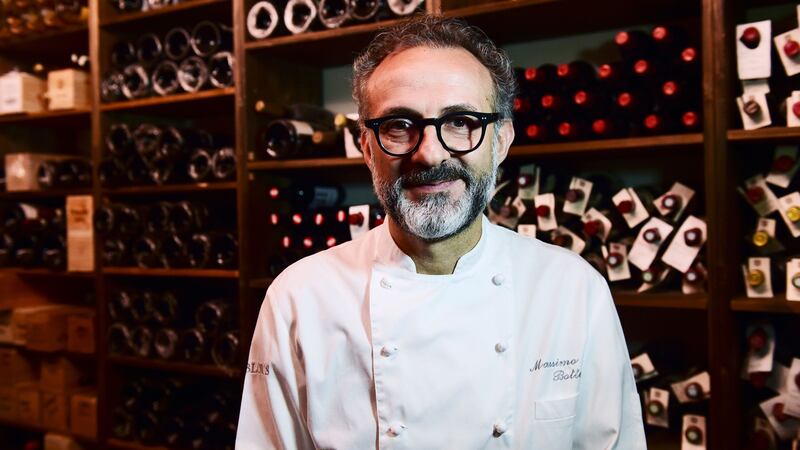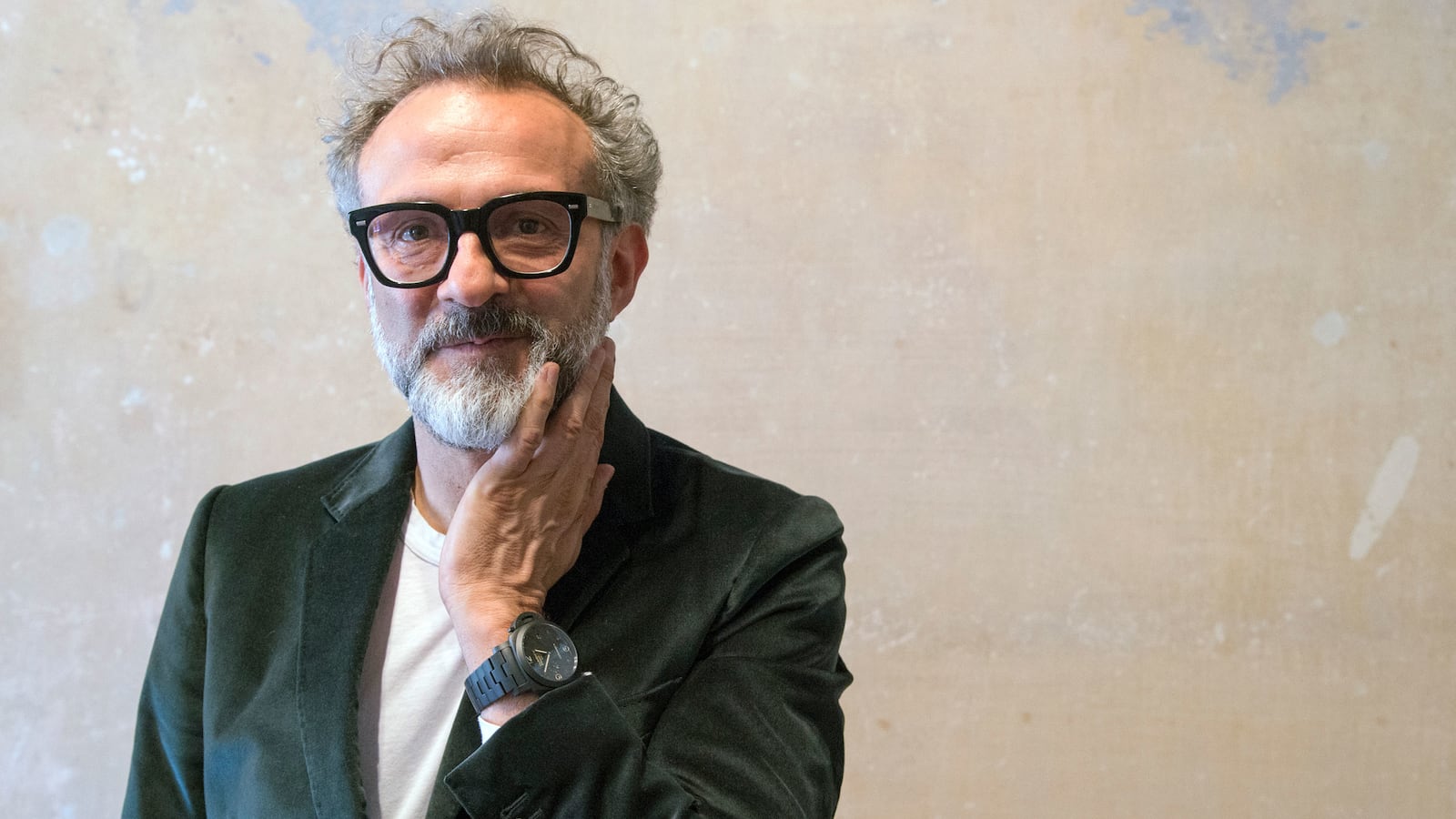Massimo Bottura is one of those incredibly rare and exotic humans to have been told that their restaurant is the world’s best, and therefore that they are one of the greatest chefs on the planet. It ranks him with the likes of Ferran Adrià, René Redzepi and Joan Roca i Fontané.
Like those geniuses, Bottura is endlessly innovative, passionate and holistic about food and driven to create new possibilities it seems only he’s able to see.
His famous restaurant Osteria Francescana in Modena, Italy, opened in 1995, and immediately garnered attention for being stunningly good and startlingly fresh. The cuisine blended traditional Italian methods with a panoply of new ideas, and subsequently included culinary techniques and flavors he experienced from his travels. In 2016, it was first named Best Restaurant in the world by the World’s 50 Best Restaurants organization that creates an annual list. Again in 2018, Osteria Francescana took the top spot. (Understandably, there will be no list in 2020.)
Among his other projects, he has collaborated with Gucci to create Gucci Osteria da Massimo Bottura in Florence, in the old Gucci Museum. He also opened a restaurant with the famed fashion brand in Beverly Hills. Last year, he partnered with W Hotels and launched Torno Subito in Dubai, and debuted Casa Maria Luigia, his boutique 12-room luxury hotel and restaurant in Modena. You’ll want to eat in when you stay there.
In 2015, at the Universal Expo in Milan, Bottura opened the Refettorio Ambrosiano with the Caritas Ambrosiana organization. It was a place to feed the hungry, with food left over from the Expo. “We oversaw the restoration of an abandoned theatre in the outskirts of Milan and transformed it into a beautiful community space. A solid ground where people could catch their breath and start believing in their future again. We made visible the invisible in Milan,” he explained to me.
“We called chefs from all over the world to join our community kitchen and cook with the food surplus coming from the Expo. Every day, we had to be as creative as we could be, to serve our guests—people living in vulnerable situations from Milan’s neighborhood of Greco. We wanted it to be the best three-course meal they had ever experienced and serve it in a warm and welcoming place.”
After the Expo, it became clear to him “that food could be more: not only a bridge between hunger and waste, but also a bridge for people to create new communities around nourishment.” The following year he founded the non-profit Food for Soul with his wife Lara “to shine light on the invisible potential of people, places and food.” There are now seven Refettorios outside of Italy, including in Rio de Janeiro, London and Paris, and one is planned for Mexico. Ultimately, he wants to tackle the U.S., too.
Currently, during the coronavirus pandemic, Bottura is producing a nightly cooking show on Instagram with his family called Kitchen Quarantine.
“What I have tried to communicate through Kitchen Quarantine, as well as with the work that we are doing with Food for Soul, is that everyone can do something, even now, even from our homes. Use this time to experiment with what you have in the fridge, to get to know the food you eat and spend time sharing it with your loved ones.”
Read on for his five favorite meals.

It was my 10th birthday, September 30, 1972. My family celebrated birthdays at restaurants for as long as I can remember. My older brothers made the reservation for the family meal at a little known place in the countryside of Parma.
The seven of us arrived at what looked like a piazza cafe in the middle of nowhere. The “T” sign indicating that they had a license to sell tabacchi (cigarettes) was hanging outside the door. It did not look like a restaurant but a bar selling coffee and spirits. In the back there was a dining room with wood paneling on the walls, white tablecloths and simple wood tables. But something was definitely different. This was not an ordinary osteria because there were incredible bottles of wine everywhere. The proprietor, Peppino Cantarelli was one of the trailblazing restaurateurs who began importing amazing wines from France back in the 1950s. He was also making his own blend of Cognacs in the back room.
What I remember about the meal was this perfectly cooked Guinea Hen (fara’ona) baked in a ceramic pot with the creamiest most flavorful sauce I had ever eaten. I also remember the discussion at the table was, “is there foie gras in the sauce?” Cantarelli had become an underground foodie stop for gourmets from all over Europe, before the term “foodie” existed. The film troupe of Bernardo Bertolucci’s 1900 (Robert DeNiro, Donald Sutherland, Gérard Depardieu) were eating lunch and dinner there every day. He was primarily known for his wine selection but also for his wife Mirella’s cooking and his attention to local products such as culatello and traditional pasta recipes. Mirella passed away in the ’80s and the restaurant closed shortly thereafter; however, it remains in the minds and hearts of many people. A legendary restaurant. What stuck with me, and still is part of me, is that a restaurant is not about the facade or the pomp and circumstance but about the substance of what happens inside and at the table.
George Coigny was a French chef at the helm of L’Antica Osteria del Teatro in Piacenza with 2 Michelin stars in the late 1970s. He fell in love with Lucia, a woman from the nearby Piacenza Hills and decided to retire and open a restaurant there. I still remember to this day everything I ate at La Cantoniera. I had opened my own restaurant, Trattoria del Campazzo, in 1986, and as a self-taught chef was eager to learn from anyone and everyone. There I experienced for the first time a perfect juxtaposition between French culinary techniques and local Emilian ingredients. I can still taste the ambrosia of foie gras or the morel mushrooms stuffed with roasted turkey mousse in mushroom juice or the chocolate demi-cui soufflé cake. George and I bonded over that meal and I asked him if I could intern with him on Mondays when Trattoria del Campazzo was closed. And so this became my first culinary training outside of my mother’s kitchen. George is no longer with us but I talk about him often to my staff and have dedicated many dishes to him.
Since I began traveling in the 1980s, I have tried street food from all over the world, from Mexico to Taiwan. But the most memorable moment happened one night in Bangkok in 2009.
I was cooking our Italian menu at the Sukhothai Hotel with two young chefs from my team, Davide di Fabio and Taka Kondo. After service one night, the chefs took us out for street food. Actually, they took us to a parking lot on the corner of a busy boulevard with crazy traffic. I remember a woman who looked like she was 100 sitting on a plastic chair under a lamppost taking the money and her husband behind a counter with a ladle and cauldron of hot soup. It was around midnight, still hot and sticky, but there still were bicycles, cars, Vespas and people walking by. We took our thee bowls of Tom Kha Gai Soup to the bench with three beers. Davide made the mistake of ordering his soup “extra spicy.” Even the guy behind the counter said, “Really?” Davide is from Southern Italy, so he is accustomed to hot spices. By the second spoonful his nose started bleeding from the hot spices and Taka and I began laughing so hard we almost missed the elephant walking by.
On the plane ride back to Italy, I started imagining how to travel with the palate and began a series of dishes using iconic Italian ingredients with a hint of flavors from around the world. Our kitchen has never been the same.
I had eaten sushi before, even in good sushi restaurants in Tokyo, New York and London but nothing had prepared me for the experience at the countertop of Jiro’s underground sushi den in the Ginza metro station. I had Japanese chefs working at Osteria Francescana and they had tried to explain the magic around the sushi cutting techniques but until I tasted it, I didn’t fully understand.
It was a revelation. What was so completely different from all the other sushi experiences I had had up to that moment was the texture revelation that Jiro creates through his cuts and treatment of the fish. Calamari took on a whole new meaning. Eel was comparable to the best desserts I’ve ever eaten in my life. But most of all, I was blown away by the rice: the acidity, the temperature and the texture. And I finally understood that sushi is all about the knife, the rice, and an obsession with fish.
Perhaps, the most memorable of all meals, was the last Christmas Eve dinner we sat around my mother’s dining table and shared a family meal with my brothers and sisters and our families before my mother passed away a month later, in January 2014. She had been in the hospital since October and celebrated her 89 birthday there in November and all she asked for was to be home for Christmas. My entire childhood revolved around meals with my five brothers, mother and father, aunts and uncles and grandmothers all squeezed around the dining room table in the middle of the kitchen. We are a noisy family that likes to eat and drink and play jokes. We all knew that this might be Luisa’s last Christmas, so we pushed to get her home in time to celebrate it together. We all cooked something that she loved. I made a copy of the roast Guinea fowl from my memory of Cantarelli, and my brother Paolo made the pasta with clams that my mother loved. My sister made zuppa Inglese and my brother Marco brought the wine.
We laughed and ate too much as we did every year. At midnight, instead of going to mass, we sat around the table telling stories. At that moment, I broke the news to my mother that I recently had spoken with the Cardinal in Milan and together we were going to open a soup kitchen in Milan, the Refettorio Ambrosiano, during the upcoming Universal Expo, to help feed the poor. Pope Francis had given us encouragement and his blessing. As a deeply religious Catholic, my mother took this news as something of great importance, much more than the 3 Michelin stars I had earned in 2012 or the international accolades. Finally, her son was using his culinary skills and the voice that had matured in him to lead an ethical campaign about fighting food waste and social isolation. This was her triumph and to me one of the most significant moments in my career. I like to think that we gave her the night of her life as a thanks for all the wonderful meals she cooked for us and the gift of teaching us to love the kitchen. I certainly would not be chef if it wasn’t for her. Thank you, mamma Luisa.
My Five Favorite Meals features the most cherished dining experiences of bartenders, chefs, distillers and celebrities.
Interview has been condensed and edited.


